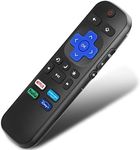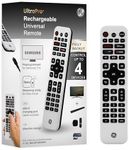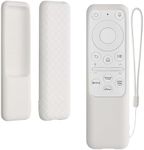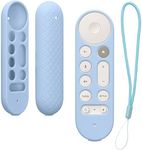Buying Guide for the Best Universal TV Remotes
Choosing a universal TV remote can make your entertainment setup much simpler by allowing you to control multiple devices with a single remote. The key is to find one that is compatible with your devices, easy to use, and has the features you need. Before buying, think about the devices you want to control, how many functions you need, and how comfortable you are with programming or setting up the remote.Device CompatibilityDevice compatibility refers to the range of brands and types of devices the remote can control, such as TVs, soundbars, streaming boxes, and DVD players. This is important because not all remotes work with every device. Some are limited to certain brands or types, while others are more universal. When looking at compatibility, check if the remote supports all the devices you want to control. If you have a mix of older and newer devices, make sure the remote can handle both. The best fit is a remote that lists your device brands and types in its compatibility guide.
Number of Devices SupportedThis spec tells you how many separate devices you can control with one remote. Some remotes are designed for just two or three devices, while others can handle five or more. If you only have a TV and a soundbar, a basic remote will do. If you have a more complex setup with a TV, streaming box, Blu-ray player, and audio system, look for a remote that supports more devices. Choose based on the number of devices you want to control now, and consider if you might add more in the future.
Programming MethodProgramming method is how you set up the remote to work with your devices. Some remotes use manual code entry, where you enter a code for each device, while others offer automatic code search or even app-based setup. Manual code entry can be a bit tedious but is reliable. Automatic code search is easier but may take longer to find the right code. App-based setup is the most user-friendly if you are comfortable with smartphones. Pick a method that matches your comfort level with technology and how much time you want to spend on setup.
Button Layout and DesignButton layout and design affect how easy the remote is to use. Some remotes have a simple layout with only the most-used buttons, while others have many buttons for advanced functions. A simple layout is best if you want something easy to use and don’t need extra features. If you want to control more functions, like smart TV apps or audio settings, look for a remote with more buttons and clear labeling. Choose a design that feels comfortable in your hand and matches your usage habits.
BacklightingBacklighting means the buttons light up, making it easier to use the remote in the dark. This is especially useful if you often watch TV at night or in dim rooms. Some remotes have full backlighting, while others only light up a few buttons or none at all. If you value convenience and often use your remote in low light, look for one with good backlighting. If you mostly use your remote during the day, this feature may not be as important.
Learning FunctionA learning function allows the remote to 'learn' commands from your original remotes by pointing them at each other. This is useful if you have unique devices or functions that aren’t covered by standard codes. Not all universal remotes have this feature. If you have special equipment or want to make sure every function is covered, look for a remote with a learning function. If your devices are common and you only need basic controls, this may not be necessary.

















